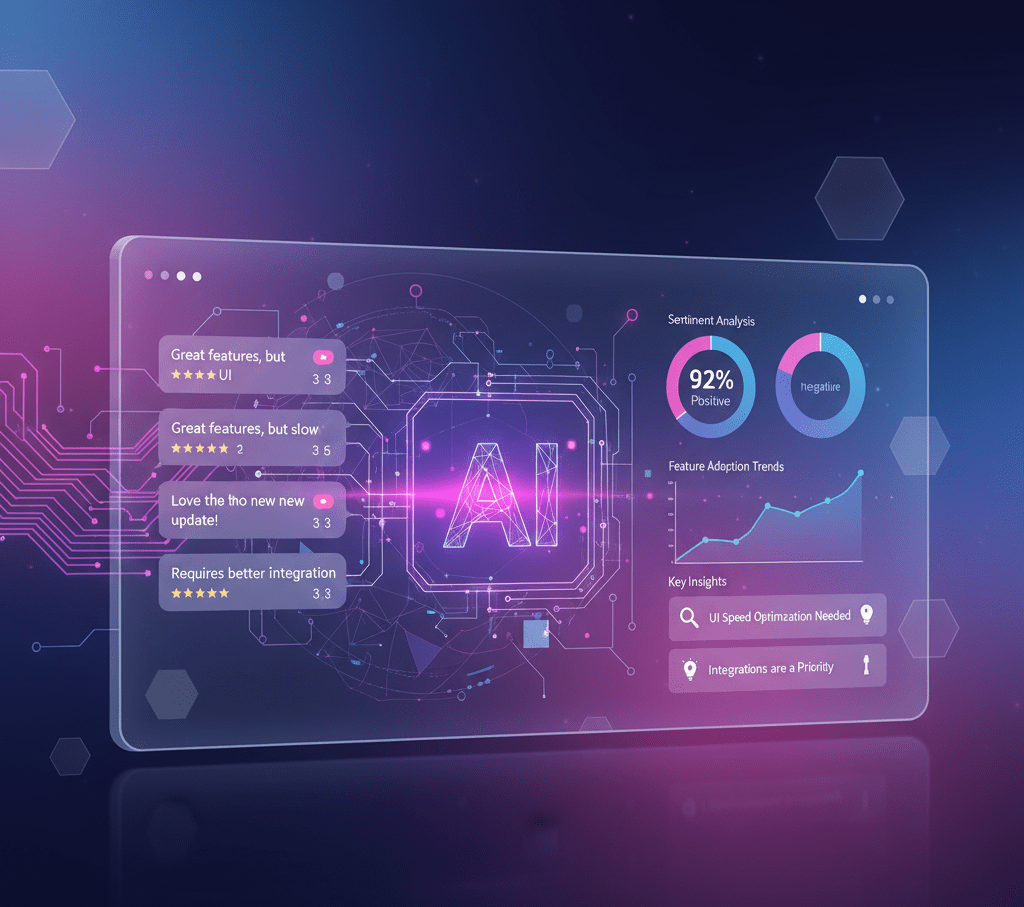“Collect, analyze, and leverage unstructured user conversations with AI for SaaS user feedback collection to perfect your product roadmap and reduce team bias from day one.”
It’s 3:00 PM on a Tuesday. Your lead solutions architect, a brilliant engineer who commands a top-tier salary, hangs up from a 90-minute “discovery call.” The prospect? A very enthusiastic entrepreneur with a revolutionary idea for a social media app that will, and I quote, “be the next Facebook.” The budget? A firm $5,000.
If you run or work at a custom software development agency, this scene is painfully familiar. You feel your stomach clench. That’s 90 minutes of your most valuable, non-billable resource’s time gone. Poof. Vanished. It’s time that could have been spent architecting a real solution for a real client, mentoring junior developers, or contributing to your internal frameworks. Instead, it was spent politely explaining that a Facebook-killer costs a little more than a used car.
This isn’t just an annoyance; it’s a critical business problem. The lifeblood of a custom software firm is the expertise of its senior technical staff. Every minute they spend on calls with unqualified, tire-kicking leads is a direct drain on your profitability and a direct path to burnout for your best people. The traditional sales process, where every inbound lead gets a piece of your top talent’s time, is broken. It’s inefficient, expensive, and demoralizing.
But what if you could build a gatekeeper? A smart, tireless, and technically-savvy filter that could stand guard, engage with every new prospect, and only allow the genuinely viable, profitable project opportunities through to your team. What if this gatekeeper could work 24/7, conduct perfect initial discovery calls every single time, and hand-deliver qualified, well-understood leads to your architects?
This isn’t a fantasy. This is precisely what AI can do for your agency right now. This guide will walk you through the staggering cost of unqualified leads, provide a robust framework for vetting prospects, and then show you how an AI agent, like SalesCloser.ai, can become your ultimate “technical presales” specialist, transforming your sales process and protecting your most precious asset: your team’s time.
The Crushing, Hidden Costs of a Bad Lead
We all know unqualified leads are bad, but most agencies dramatically underestimate the actual damage they inflict. It goes far beyond a single wasted hour on the calendar. The costs are financial, strategic, and cultural, and they compound over time.
The Direct Financial Drain
Let’s do some quick, back-of-the-napkin math. Let’s say your lead architect makes a conservative $160,000 per year.
- Annual Salary: $160,000
- Work Weeks per Year: ~50 (assuming 2 weeks vacation)
- Hours per Week: 40
- Total Hours per Year: 2,000
- Architect’s Hourly Cost: $160,000 / 2,000 hours = $80/hour
Now, a “one-hour” discovery call is never just one hour. There’s prep time (reviewing the initial inquiry and researching the company) and debrief time (writing notes and updating the CRM). Let’s call it 1.5 hours per call.
- Cost per Unqualified Call: 1.5 hours * $80/hour = $120
That might not seem like a lot. But how many of these calls happen? If your agency gets a decent amount of inbound interest, you might have five of these calls a week.
- Weekly Cost: 5 calls * $120/call = $600
- Monthly Cost: ~$2,400
- Annual Cost: ~$28,800
You are spending nearly $30,000 a year for your best technical minds to talk to people who will never, ever become clients. That’s money that could go toward a new hire, a significant marketing campaign, better benefits, or straight to your bottom line. And this calculation only accounts for one senior team member. If your process involves both an architect and a project manager, you can double that number. The financial reality is staggering when you actually take the time to calculate it.
The Opportunity Cost Nightmare
The direct financial cost is only the beginning. The opportunity cost is much worse. Every hour your architect spends with a bad lead is an hour they are not spending on value-generating activities.
- Billable Work: This is the most obvious. That hour could have been billed to an existing client, directly generating revenue.
- Improving Current Projects: They could have been solving a complex technical challenge for a current client, ensuring project success and client retention.
- Sales Enablement: They could have been crafting a brilliant technical proposal for a qualified lead, which would have helped close a six- or seven-figure deal.
- Innovation and R&D: They could have been exploring new technologies, building reusable components, or improving your agency’s development processes—work that makes your entire operation more efficient and competitive.
- Mentorship: They could have been mentoring your mid-level and junior developers, leveling up your entire team’s skill set.
Unqualified leads don’t just cost you money; they steal your future. They starve your business of the very innovation and focus required to grow.
The Team Morale Killer
Top-tier technical talent is incredibly difficult to find and retain. These individuals are driven by a desire to solve complex problems and build amazing things. When you repeatedly pull them into pointless sales meetings with unqualified prospects, you send a clear message: “Your time and expertise are not valuable.”
Nothing burns out a great engineer faster than corporate wastefulness. They see their time, their most finite resource, being squandered. It’s frustrating. It’s disrespectful. They start to wonder if their skills would be better utilized elsewhere, at a company that protects its talent and uses them for what they were hired to do. High turnover on your senior technical team is a death sentence for a custom software agency, and a broken lead qualification process is a direct contributor to that churn. It clogs the pipeline, makes sales forecasting a guessing game, and forces the entire team to spin its wheels chasing ghosts.
The Qualification Fortress: A Four-Stage Framework
Before we unleash an AI, it’s crucial to understand what a rock-solid, manual qualification process looks like. You can’t automate a process you haven’t defined. Think of this as building a medieval fortress to protect your castle (your senior developers). Each stage is a new wall, and only the most worthy suitors make it through to the inner sanctum.
Stage 1: The Moat (The Initial Web Form)
This is your first line of defense. It’s simple, but it’s designed to filter out the absolute lowest-quality inquiries and spam. Your “Contact Us” form shouldn’t just be Name, Email, and Message. It needs to be smarter.
- What it asks:
- Basic contact information (Name, Work Email, Company, Website). Using “Work Email” helps filter out non-serious inquiries from personal email addresses.
- A brief, mandatory project description. A single sentence is fine. The goal is to make them think for at least 10 seconds.
- A dropdown for project type (e.g., “New Web Application,” “Mobile App,” “System Integration,” “Legacy System Modernization”). This helps you route the inquiry internally.
- A simple “How did you hear about us?” This is valuable marketing data.
- The Goal: To weed out spam and people who aren’t willing to spend 60 seconds to articulate their needs. If they can’t fill out a simple form, they are not ready for a custom software project.
Stage 2: The Outer Wall (The BANT Screen)
This is where the real qualification begins. Any lead that makes it through the moat should now be subjected to the BANT test. BANT is a classic sales framework that stands for Budget, Authority, Need, and Timeline. A junior salesperson or an account coordinator can handle this. The goal is to get straight, honest answers to the four most important questions.
- Budget: This is the big one. Don’t ask, “What’s your budget?” It’s confrontational, and people will lie or say they don’t know. Instead, use bracketing. Be upfront about your costs.
- Good Script: “Thank you for your interest. To ensure we’re on the same page and respect your time, our typical custom software projects begin at $75,000 for an initial phase. Does your project’s allocated budget fall into one of these ranges: $75k-$150k, $150k-$300k, or $300k+?”
- Why it works: It establishes you as a premium service, sets expectations, and forces an honest answer without being aggressive. Anyone who balks at the minimum figure is immediately disqualified.
- Authority: Determine whether you’re speaking with the decision-maker or an intern on a research mission.
- Good Script: “To ensure we bring the right people to our next conversation, could you tell me who else on your team will be involved in the decision-making process for this project?”
- Why it works: It’s a polite way of asking, “Are you the person who can actually sign a contract?” If they are the sole decision-maker, great. If not, you know you need to involve the real stakeholders.
- Need: You need to understand the “why” behind the project. A strong business need creates urgency and justifies the budget.
- Good Script: “Could you walk me through the business problem you’re trying to solve? What happens if you don’t build this software in the next six months?”
- Why it works: This uncovers pain points. If the answer is “Oh, nothing much, it would just be nice to have,” there’s no urgency. If the answer is “Our biggest competitor just launched a similar feature and we’re losing customers,” you’ve found a highly motivated buyer.
- Timeline: This separates the “we need it yesterday” projects from the “maybe next year” ideas.
- Good Script: “What’s your ideal timeline for having a solution in place? Are there any specific events, like a product launch or a trade show, driving that deadline?”
- Why it works: It helps you understand their urgency and plan your own resource allocation. A project with a hard, business-driven deadline is always more valuable than one with a vague, floating timeline.
Stage 3: The Inner Wall (The Technical Litmus Test)
Leads that pass the BANT screen are promising. They have a real budget, a compelling need, and a reasonable timeline. Now, before they get your lead architect’s time, they need to pass one more test. This is a shorter, 20-30-minute call, still handled by a pre-sales engineer or a technically-minded project manager, rather than your top architect.
- What it asks:
- “Can you describe the core features of the Minimum Viable Product (MVP)?”
- “Are there any existing systems or APIs we would need to integrate with?”
- “Do you have any technology stack preferences or constraints?”
- “What are your key concerns regarding security, scalability, or data privacy (e.g., HIPAA, GDPR)?”
- The Goal: To ensure the prospect has thought through their needs on a technical level. You’re not designing the solution here; you’re just checking if they’ve done their homework. If they can’t answer these basic questions, they’re not ready for a deep dive into architectural discussion.
Stage 4: The Inner Sanctum (The Architect’s Deep Dive)
This is it. The promised land. Only leads who have passed through the moat, the outer wall, and the inner wall get access to your lead architect.
- What happens here: This is the valuable, consultative call. The architect can now confidently invest their time, knowing they are speaking with a well-funded, serious prospect with a clearly defined need and a basic technical outline. They can discuss architecture, trade-offs, and potential solutions.
- The Result: Instead of being a waste of time, this call becomes the most critical step in closing a high-value deal. The architect shines, the client is impressed, and you create a detailed, accurate proposal that wins the business.
This four-stage fortress is incredibly effective. But it still requires significant human time for stages 2 and 3. Now, let’s discuss how to automate the gate guards.
The AI Revolution: Automating Your Gatekeepers
The manual framework is robust, but Stages 2 and 3 still consume a significant amount of time from your team. A junior salesperson can handle Stage 2, and a mid-level engineer can handle Stage 3; however, both remain repetitive and time-consuming processes. The calls can be inconsistent, details can be missed, and it still acts as a bottleneck.
This is where AI changes the entire game.
Imagine an AI agent specifically designed to execute Stages 2 and 3 of your qualification fortress. Not a simple website chatbot that follows a rigid script, but a true AI that gets on a voice call, has a natural conversation, understands context, and asks intelligent follow-up questions. This is a “technical presales” agent, and its only job is to run the BANT and Technical Litmus Test calls on your behalf.
Let’s break down how this AI automates the process with a level of consistency and efficiency that’s impossible to achieve with humans alone.
- Automating the BANT Screen: The AI can be programmed with your exact qualification criteria.
- Budget: The AI can execute the bracketing technique perfectly every time. It can be trained to respond to common budget-related objections. If a prospect says, “The budget isn’t finalized yet,” the AI can pivot: “I understand completely. Based on the requirements you’ve mentioned so far, similar projects typically land in the $150k to $200k range. Does that rough order of magnitude feel comfortable for your stakeholders?” This is a sophisticated, consultative question that the AI can ask without emotion or hesitation.
- Authority: The AI can ask about the decision-making unit and even map it out. “Great. So, just to confirm, the evaluation team consists of you as the project lead, Sarah from Marketing, and the final sign-off comes from the CTO, David? Is that correct?”
- Need: This is where an advanced AI truly excels. It can automate user interviews at a foundational level. It can ask open-ended questions, such as “Walk me through the current manual process you’re trying to replace,” and let the prospect talk for five minutes. The AI doesn’t get bored or impatient. It listens, transcribes everything, and can even pull out key pain points from the conversation. This is how you get qualitative user data from the very first touchpoint.
- Timeline: The AI can clarify deadlines and probe for the business drivers behind them, separating wishful thinking from reality.
- Automating the Technical Litmus Test: You can train the AI on your company’s technical expertise, case studies, and common project types.
- It can ask about required integrations, tech stack preferences, and compliance needs.
- Crucially, it can also answer many of the prospect’s initial technical questions. If a lead asks, “Do you have experience building HIPAA-compliant healthcare apps?” the AI, trained on your case studies, can instantly respond, “Yes, we do. We recently completed a project for a telehealth platform that required end-to-end encryption and HIPAA-compliant data storage on AWS. I can ensure the architect has the full case study to discuss with you.”
This AI-driven process is more than just a filter. It’s an intelligent data collection machine that prepares the perfect conversation for your human experts.

Meet SalesCloser.ai: Your 24/7 Technical Presales Agent
The concept of an AI presales agent is powerful, and SalesCloser.ai is the platform that makes it a reality. It’s designed to be the ultimate gatekeeper for your custom software agency, embodying the principles of the qualification fortress and executing it with flawless precision.
Think of SalesCloser.ai not as a piece of software, but as your first, and most diligent, sales hire.
Autonomous, Voice-Based Discovery Calls
This is the critical difference. SalesCloser.ai isn’t a text-based chatbot. When a lead comes in, the AI schedules and conducts an actual voice call. It engages the prospect in a natural, conversational way, asking the tough qualifying questions you need answered. It never has a bad day, it’s never tired, and it follows your script perfectly while still adapting to the flow of the conversation.
Deep Technical Training
You can “teach” SalesCloser.ai everything about your business. You feed it your case studies, blog posts, service descriptions, and past project proposals. It ingests this information and learns what you do, who you do it for, and how you do it. This enables it to have credible, technically grounded conversations and answer a prospect’s initial questions with confidence, establishing your agency’s authority from the very first call.
Intelligent Lead Scoring and Summarization
After every call, SalesCloser.ai gets to work. It analyzes the entire conversation transcript against your BANT and technical criteria. It then generates a lead score, instantly indicating whether this is a hot prospect or a dead end.
More importantly, it provides a concise, executive summary of the call, complete with key quotes, identified pain points, budget confirmation, and stakeholder mapping. Your architect no longer walks into a call blind. They receive a comprehensive dossier on the prospect, enabling them to prepare for a productive and consultative session.
The Perfect Handoff
- For Qualified Leads: If a lead meets your predefined score, SalesCloser.ai can automatically take the next step. It can send a personalized email summary to the prospect and present them with a booking link for your senior architect’s calendar. The entire process, from inquiry to a booked meeting with a fully vetted lead, can happen with zero human intervention.
- For Unqualified Leads: The lead is not simply discarded. SalesCloser.ai sends a polite, professional email explaining that it isn’t a good fit at this time. It can suggest alternative resources, like a guide to budgeting for a software project or a link to a relevant blog post, keeping the door open for the future while gracefully disqualifying them from the active sales pipeline.
Before and After: The AI-Powered Workflow
Let’s visualize the transformation. The impact on your agency’s efficiency is not incremental; it’s a complete paradigm shift.
The Old Way (Before AI)
- Lead In: A prospect fills out a basic contact form on your website.
- Manual Triage: A sales rep or office manager spends 15 minutes reviewing the lead and emailing back and forth to schedule an initial call.
- Pointless Call #1: The sales rep spends 20 minutes on a call, realizes the budget is tiny, but doesn’t want to disqualify them too harshly.
- The Fateful Meeting: The sales rep schedules a “Technical Discovery” call with your lead architect, hoping for the best.
- Wasted Time: The architect spends 90 minutes on a call, slowly realizing this project is a non-starter.
- The Aftermath: The architect is frustrated. The sales rep is apologetic. The CRM is updated. The lead goes cold.
- Total Human Time Invested (for a dead end): Over 2 hours.
The New Way (With SalesCloser.ai)
- Lead In: A prospect fills out your smart web form.
- AI Engages: SalesCloser.ai immediately sends an email and a booking link for an “Initial Scoping & Qualification Call.”
- AI Conducts the Call: The AI has a 20-minute voice conversation with the lead, executing the BANT and Technical Litmus Test perfectly.
- AI Analyzes & Scores: Within minutes of the call ending, the AI analyzes the transcript, scores the lead against your criteria, and generates a detailed summary.
- The Smart Handoff:
- IF QUALIFIED: The AI automatically sends a summary to your architect and a calendar link to the prospect for the “Architectural Deep Dive.” The architect accepts, walking into the meeting fully informed and prepared for a high-value conversation.
- If unqualified, the AI automatically sends a polite disqualification email with helpful resources, placing the lead into a long-term nurture sequence.
- Total Human Time Invested (until fully qualified): Zero.
Your most valuable team members are now 100% protected. They only engage with prospects who have been confirmed to have a sufficient budget, the authority to make a decision, a clear and urgent need, and a defined timeline.
Beyond Qualification: AI for Deeper User Understanding
The most exciting part of using an AI agent like SalesCloser.ai is that its value extends far beyond simple lead qualification. It doubles as a powerful user research automation tool, providing deep insights before a single line of code is written.
Your Unbiased User Research Tool
The transcripts from these AI-led calls are a goldmine of raw, unfiltered user feedback. This becomes the foundation of your customer feedback loop, starting from the very first interaction. When prospects describe their problems, they use their own language, revealing their true priorities and pain points.
Unlike a human salesperson who might subconsciously filter a conversation through the lens of “what do I need to say to close this deal?”, the AI has no bias. It is a perfect, impartial record keeper. This is invaluable for reducing product team bias later in the process. You get to hear exactly what the user needs, not a salesperson’s interpretation of what they think the user needs. This makes it one of the most effective product management AI tools you can use, even before the project is officially a “product.”
Improve the Product Roadmap Before Day One
By analyzing the transcripts from a dozen qualified leads, you’ll start to see patterns. You’ll hear the same frustrations, the exact feature requests, and the same business goals repeatedly. This collective intelligence enables you to create the product roadmap for the custom software you’re about to develop. You can go into the kickoff meeting with the client and say, “Based on our initial conversations with your team, it seems the three most critical areas to address are inventory tracking, report generation, and third-party shipping integration. Let’s start there.”
This level of proactive understanding demonstrates a deep commitment to solving the client’s actual problems and sets your agency apart from competitors who are just order-takers. You’re not just waiting for the client to talk to your users; you’re facilitating that conversation from the very first touchpoint, gathering that precious qualitative data, and using it to build a better solution. This is the essence of AI for SaaS user feedback collection—applied to the custom software world.
Stop Wasting Time, Start Closing Better Deals
Your developers and architects are your superstars. They are the engine of your business, the creators of value, and your single greatest competitive advantage. It’s time to stop treating their time as an infinite commodity. It’s time to protect them.
By building a robust qualification fortress and empowering it with a tireless AI gatekeeper like SalesCloser.ai, you can fundamentally change the economics of your sales process. You can stop the financial drain, eliminate opportunity costs, and boost team morale.
The goal isn’t to replace your sales team; it’s to supercharge them. It’s about automating the repetitive, low-value, top-of-funnel work to free up your human experts to do what they do best: build relationships, design brilliant solutions, and close profitable deals with clients who are ready, willing, and excited to work with you.
Ready to protect your architects’ time and transform your lead qualification process?
Frequently Asked Questions (FAQs)
Q1: Will a prospect be put off by talking to an AI?
A: It’s all about framing. You don’t position it as “talking to a robot.” You frame it as a highly efficient “Initial Technical Scoping Session” designed to gather all the necessary information to make the follow-up call with the senior architect as productive as possible. Prospects appreciate efficiency and a well-defined process.
Q2: How intelligent is the AI? Can it handle complex, nuanced conversations?
A: Modern conversational AI is incredibly advanced. By training it on your company’s specific documentation, case studies, and successful sales call transcripts, a tool like SalesCloser.ai can handle a surprising amount of complexity. It understands context, can answer specific technical questions it has been trained on, and can ask intelligent follow-up questions. It’s far more capable than a simple, script-following chatbot.
Q3: What happens if a significant lead has a very unique project that doesn’t fit the script?
A: This is a key feature of a good AI agent. It is designed to recognize the limits of its knowledge. Suppose a prospect’s needs are highly unusual or fall outside of its training data. In that case, the AI can be programmed to recognize this, flag the conversation for immediate human review, and seamlessly transition the lead to a human team member. You don’t lose the opportunity; you just get it to the right person faster.
Q4: How is this different from the chatbot we already have on our website?
A: The difference is massive. A chatbot is a text-based tool that follows a rigid, decision-tree-like script. It’s suitable for answering simple, repetitive questions. SalesCloser.ai facilitates real-time, dynamic voice conversations. It understands nuance, can navigate complex topics, and can perform a sophisticated qualification process that is simply impossible for a text-based bot.
Q5: Does this replace our junior sales staff (SDRs)?
A: It doesn’t replace them; it evolves their role. Instead of spending 80% of their day making repetitive qualifying calls, your SDRs can now focus on higher-value activities. They can manage the AI, review call transcripts for insights, conduct strategic outbound prospecting to high-value accounts, and focus on building relationships with the qualified leads the AI delivers. It turns your SDRs from call-makers into strategic account managers.
Q6: What is the setup and training process like?
A: It’s simpler than you might think. You provide the platform with your existing materials, including website copy, case studies, service descriptions, and any sales scripts you already use. The AI platform ingests and processes this data to build its knowledge base. Then, you work with the system to define your specific BANT criteria and lead scoring rules. There’s a refinement period where you review its first few calls and provide feedback, continuously making it more innovative and more effective over time.








